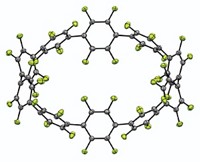Advertisement
Grab your lab coat. Let's get started
Welcome!
Welcome!
Create an account below to get 6 C&EN articles per month, receive newsletters and more - all free.
It seems this is your first time logging in online. Please enter the following information to continue.
As an ACS member you automatically get access to this site. All we need is few more details to create your reading experience.
Not you? Sign in with a different account.
Not you? Sign in with a different account.
ERROR 1
ERROR 1
ERROR 2
ERROR 2
ERROR 2
ERROR 2
ERROR 2
Password and Confirm password must match.
If you have an ACS member number, please enter it here so we can link this account to your membership. (optional)
ERROR 2
ACS values your privacy. By submitting your information, you are gaining access to C&EN and subscribing to our weekly newsletter. We use the information you provide to make your reading experience better, and we will never sell your data to third party members.
Materials
Powerful annulation fuses polyaromatics
New method overcomes obstacles to making valuable electronic materials
by Tien Nguyen
February 5, 2018
| A version of this story appeared in
Volume 96, Issue 6

More than a century ago, chemists discovered the homocoupling of aryl halides, in which a copper catalyst convinces twin halogen atoms to give up their positions to bring together two aryl rings. This mighty dimerization reaction has long dominated biarene synthesis. Now, scientists are offering an upgrade. A research team at Nagoya University, led by Kei Murakami and Kenichiro Itami, has developed an annulative dimerization reaction of chlorophenylenes that connects the rings with two new bonds instead of one (Science 2018, DOI: 10.1126/science.aap9801). In the reaction, a palladium catalyst with bulky adamantane ligands promotes dual carbon-hydrogen bond activation events to produce the partially fused triphenylene core structure. This type of π-conjugated architecture holds precious properties for modern applications such as organic light-emitting diodes and photovoltaics. Itami notes that the partially fused arenes can be successfully “zipped up” to the fully fused polyaromatic structure using the iron-catalyzed Scholl reaction. Previous attempts to use this route starting from nonfused arenes have been plagued with undesirable side reactions. This additional step provides access to graphene nanoribbon materials, which are coveted for their unique optoelectronic properties.





Join the conversation
Contact the reporter
Submit a Letter to the Editor for publication
Engage with us on Twitter